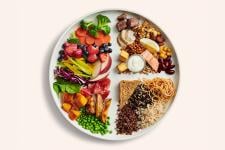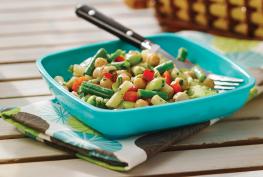Vegetables and fruit are an important part of healthy eating. They come in many forms, such as fresh, frozen and canned.
On this page
Vegetables and fruits are good for you
Vegetables and fruits are an important part of a healthy eating pattern. Eating a variety of vegetables and fruits may lower your risk of heart disease.
Vegetables and fruits have important nutrients such as:
- fibre
- vitamins
- minerals
Include plenty of vegetables and fruits in your meals and snacks. Try making half of your plate vegetables and fruits.
Opt for different textures, colours and shapes to fit your taste. From apples to zucchini, choose plenty of vegetables and fruits.
Try a variety of vegetables and fruits such as:
- pears
- apples
- berries
- peaches
- cabbage
Eat dark green vegetables every day. Dark green vegetables can help you get enough folate and calcium. Dark green vegetables include:
- okra
- rapini
- Chinese broccoli
- some seaweed, such as
- kelp
- dulse
- wakame
- bok choy
- some leafy greens, such as
- kale
- arugula
- watercress
- turnip greens
- mustard greens
Eat orange vegetables a few times a week. Orange vegetables can help you get enough vitamin A. Orange vegetables include:
- carrots
- pumpkin
- sweet potato
- red and orange peppers
- butternut and hubbard squash
Choosing and preparing healthy vegetables and fruits
Fresh, frozen or canned vegetables and fruits can all be healthy options.
Frozen and canned vegetables and fruits:
- take little time to prepare
- are a healthy and convenient option
- are just as nutritious as fresh vegetables and fruits
Fruit juice and fruit juice concentrates are high in sugars. Replace juice with water. Choose whole or cut vegetables and fruits instead of juice.
Frozen vegetables and fruits
Choose frozen vegetables and fruits without:
- added sugars
- added seasonings
- breading or rich sauces
You can add frozen vegetables and fruits to soup or chili.
Canned vegetables and fruits
Choose canned vegetables with little to no added sodium.
Drain and rinse canned vegetables to lower the sodium content.
Choose canned fruit with little to no added sugars.
Use the food labels to help you compare canned vegetables and fruits.
The % daily value helps you see if a food has a little or a lot of a nutrient.
Dried fruit
Dried fruit can be a part of healthy eating, but it can stick to your teeth and cause cavities. If you choose dried fruit, eat it with meals.
Preparing vegetables
Try healthier cooking methods like:
- baking
- roasting
- steaming
- stir-frying
Enhance the flavour by adding:
- olive oil
- lemon juice
- flavoured vinegar
- fresh or dried herbs or spices
Snack ideas
Vegetables and fruits make quick and healthy snacks. There are lots to choose from and many healthy ways to prepare them.
Vegetable snacking tips
Keep cut up fresh vegetables in the fridge for a quick and healthy snack. Try:
- broccoli
- cauliflower
- celery sticks
- cucumber slices
Serve sliced carrots or red bell peppers with a dip.
Add leafy greens such as spinach or kale to smoothies.
Fruit snacking tips
Keep a bowl of fresh fruit on the counter as an easy snack to grab.
Add fruit to whole grain cereals or lower fat yogurt. Try:
- bananas
- mangoes
- frozen berries
- canned peaches packed in water
Freeze seedless grapes on a tray and enjoy them as a snack.
How to eat more vegetables
Here are some easy ways to eat more vegetables:
- Add canned pumpkin or squash purée to any soup to make it extra rich and creamy.
- Wash, chop and refrigerate or freeze extra vegetables when preparing meals so you have extra for meals the next day.
- Use pre-bagged vegetables that can be quickly tossed in a salad, stir-fry or casserole. Try:
- baby carrots
- green beans
- leafy greens
- Serve raw vegetables with your meals. Try:
- cucumber
- cherry or grape tomatoes
- red, yellow or green peppers
- Try recipes that call for different types of leafy greens such as:
- kale
- spinach
- bok choy
- Swiss chard
- mixed salad greens
How to eat more fruits
Fruits are a delicious addition to your day. Here are some easy ways to eat more fruit:
- For dessert, choose:
- oranges
- fruit salad, with little to no added sugars
- Add fresh fruits to salads. Try adding sliced:
- pears
- peaches
- strawberries
- Add frozen fruits to baking.
- Wash, cut and refrigerate extra fruit so you can have some on hand for meals and snacks.
Make a healthy choice
What you eat on a regular basis matters for your health.
- Choose foods that have little to no added sodium, sugars or saturated fat.
- Compare the nutrition facts table on foods to choose products that are lower in sodium, sugars or saturated fat.
- Date modified:


